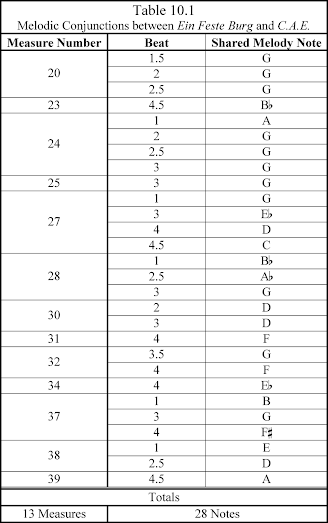The man said, “This is now bone of my bones and flesh of my flesh; she shall be called ‘woman,’ for she was taken out of man.” For this reason a man will leave his father and mother and be united to his wife, and they will become one flesh.
Following the important discovery that Ein feste Burg is the missing principal Theme of the Enigma Variations, the next step in confirming this solution was to successfully map A Mighty Fortress “through and over” each of the variations. One of the earliest candidates to undergo such an analysis was C. A. E., the first Variation. The initials stand for Elgar’s wife and dearest friend, Caroline Alice Elgar. She was an early and enthusiastic supporter of his compositions, recognizing well before her contemporaries her husband’s gift eclipsed that of a mere, provincial composer. Her family practically disowned her for stooping to the level of marrying a “jobbing” musician with no wealth, no prospects, and no future. In the end, she proved them wrong by exercising faith in her own judgment and heart, and by unselfishly supporting her husband’s work against what seemed like impossible odds. She remained a source of strength and inspiration for Elgar throughout his most productive years. It is not coincidental Elgar’s first major work, Froissart, was completed the year of his marriage to Alice. His last major work, the cello concerto, was completed a year before her death in 1920.
Figure 10.1 demonstrates it is entirely possible for Ein feste Burg to play “through and over” Variation I. An audiovisual file of this melodic mapping supports the efficacy of this contrapuntal solution.
Figure 10.2 illustrates precisely how Ein feste Burg was mapped over Variation I based on a combination of melodic interval mirroring and the principles of counterpoint. Melodic interval mirroring occurs when note intervals from Ein feste Burg are reflected in the variation over comparable or identical distances between notes. These notes do not necessarily appear in the melody line of the movement. The contrapuntal devices of similar and contrary motion were also considered in this analysis. Similar motion is when both voices move in the same direction, but not necessarily by the same degree. Contrary motion takes place when Ein feste Burg moves in the opposite direction than the variation, again not necessarily by the same interval. Similar motion is indicated by SM, and contrary motion by CM. For the purposes of this analysis, similar motion includes any instances of parallel motion, and contrary motion any instances of oblique motion. In some cases, the upper voice of the variation moves parallel with Ein feste Burg while the bass line moves in a contrary manner. An effective counterpoint typically employs a fairly balanced mix of contrary and similar motion, something clearly evident with this mapping.
In Figure 10.2 a melodic conjunction is represented by a diamond-shaped note head, and a harmonic conjunction by a triangle-shaped note head. A melodic conjunction is defined as any matching melody note between Ein feste Burg and the movement’s melody line. A harmonic conjunction is defined as a match between a melody note from the covert principal Theme and any non-melodic note from the movement. Both melodic and harmonic conjunctions must sound together to be considered a match.
Table 10.1 documents 28 shared melody notes between Ein feste Burg and Variation I, an amount equal to two times plus two of that found with the Enigma Theme (13). These melodic conjunctions are present from measures 20 to 39, a span of 19 measures. Variation I is 21 measures in length excluding the two-bar bridge with the Enigma Theme (measures 18 and 19). Further analysis reveals this two-measure bridge is an extension of the ending to the Enigma Theme, and that phrase A of Ein feste Burg plays over this section. There are 90 melody notes in Variation I and 75 melody notes in Ein feste Burg. Therefore, 37.3% of the melody from Ein feste Burg overlaps with 31.1% of the melody of Variation I. Such a high percentage supports the conclusion Variation I is a deliberate counterpoint to Ein feste Burg.
Table 10.2 condenses the data from Table 6.1 by note type and frequency. There are 11 types of shared melody notes with frequencies ranging from 1 to 11. Such a high incidence of numbers based on 1 is very appropriate for Variation I, for Alice was closest to Elgar’s heart as his wife and helpmate.
Table 10.3 shows there are 140 shared notes between Ein feste Burg and Variation I dispersed over measures 20 through 40. There are 11 shared note types with frequencies ranging from 2 to 43. Remarkably, all 11 note types are shared by both melodies. The covert Theme is dormant in measures 18 and 19, the two-bar bridge between the Enigma Theme and Variation I. In total, there are 140 notes from the piano reduction of Variation I that match 62 out of 75 melody notes from Ein feste Burg. Put another way, an astounding 82.6% of the melody notes from Ein feste Burg are embedded sequentially into the melody and score of Variation I. For such a high percentage of melody notes to appear sequentially throughout the melody and score of Variation I defies the boundaries of random chance or the capricious application of free rhythm.
Conclusion
The preponderance of the evidence outlined in the above Figures and Tables demonstrates Variation I is a clear and convincing counterpoint to Ein feste Burg. To learn more about the secrets of the Enigma Variations, read my free eBook Elgar’s Enigmas Exposed. Please support my original research by becoming a sponsor on Patreon.









No comments:
Post a Comment